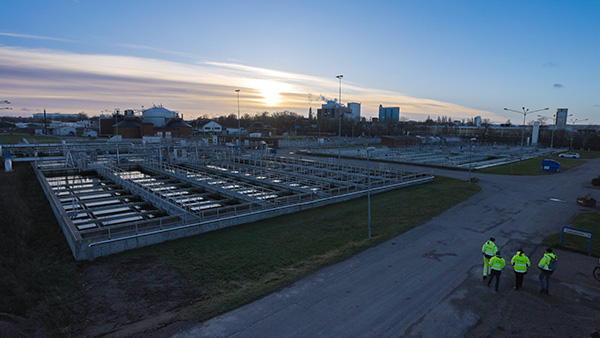Water scarcity is no longer a distant threat but an immediate challenge confronting the United States.
By Vincent Puisor, Schneider Electric, Global Business Development Director, Industrial Water
According to the Water Scarcity Report by Schneider Electric and Bluefield Research, over a third of U.S. states are already experiencing medium to high or even extreme levels of water stress. This water stress is highest in the American West with New Mexico under ‘extremely high’ water stress and states like California, Arizona, and Colorado also experiencing high water stress. The increasing strain on water resources means that innovative solutions are urgently required to manage water more efficiently.
The Environmental Protection Agency (EPA) estimates that at least $630 billion is needed to modernize the nation’s aging water infrastructure over the next two decades. Yet, addressing this financial burden without compromising water quality, affordability, and sustainability is a complex challenge. Digital technologies and automation are emerging as critical tools to meet these demands, offering the potential to reduce water consumption by up to 40% while optimizing resource use.
Industries across the U.S. are among the largest consumers of freshwater. The “Opportunities for Industrial Water” research report found that the energy sector alone withdraws nearly 52 billion gallons of water daily, equivalent to filling approximately 78,788 Olympic-sized swimming pools. Other major industrial consumers include:
These figures are expected to rise significantly by 2050, especially in sectors such as pharmaceuticals, food processing, semiconductors, and data centers, which underpin modern economies. These industries are essential to daily life and economic progress, and the goal is not to curtail their water use, but to ensure it is managed efficiently and sustainably.

Traditional water management systems in the U.S. often rely on outdated infrastructure, making it difficult to respond to the growing challenges of water scarcity, rising costs, and increased regulatory pressures. However, the integration of automation and digital technologies is reshaping how industries approach water management, offering a more efficient and sustainable future.
Software-defined automation represents a transformative breakthrough for water and wastewater utilities, enabling unprecedented flexibility by decoupling hardware and software to optimize operational efficiency, reduce energy consumption, and accelerate digital transformation. These platforms also provide new levels communication and data sharing within an operation, allowing for greater insight into energy usage, machine functionality, and process efficiency, offering more opportunities for optimization.
Beyond real-time optimization, automation also enhances predictive maintenance. With advanced data analytics, operators can monitor equipment health and predict failures before they happen. This proactive approach minimizes unplanned downtime, lowers maintenance costs, and extends the lifespan of critical infrastructure.
Automation also critically enables the implementation of circular water practices. By facilitating the reuse and recycling of water within industrial processes, companies can significantly reduce their reliance on freshwater sources and decrease wastewater discharge. These closed-loop systems not only conserve water but also help industries comply with stricter environmental regulations, aligning operational goals with sustainability.
A shift toward a circular water economy is essential to address the growing scarcity of freshwater. Currently, only 11% of wastewater is reused, with the rest often discharged into the environment. By adopting circular practices, industries can extract valuable resources, such as energy, nutrients, and metals from wastewater, transforming it from a liability into an asset.
For example, water reuse initiatives like Brazil’s Aquapolo project demonstrate the potential of circular water management. Every liter of recycled water produced saves an equivalent liter of drinking water, showcasing how industrial innovation can alleviate pressure on freshwater resources. In New Jersey, the Willingboro Municipal Utilities Authority (WMUA) implemented a significant infrastructure project to improve the sustainability and resilience of its water and wastewater facilities with 13,000 new smart water meters, which will generate $7 million in savings over 20 years.
The water sector’s impact extends beyond resource consumption. It accounts for approximately 4% of global electricity usage, contributing to greenhouse gas emissions. However, this percentage is projected to significantly increase in the coming decades. By 2040, energy consumption in the water sector is expected to more than double, potentially reaching up to 20% of electricity demand associated with water-related activities. As climate change exacerbates water scarcity, industries must balance efficiency, sustainability, and resilience.
Automation plays a crucial role in achieving this balance by:
Solving the water crisis requires a paradigm shift in how industries approach water management. Incremental improvements are no longer sufficient. Instead, industries must adopt a holistic, digital-first strategy that integrates automation, data analytics, and circular economy principles.
Universal automation, which decouples software from proprietary hardware, offers a glimpse into the future of water management. By creating a flexible, adaptable infrastructure, industries can continuously evolve their water management practices to meet emerging challenges.
Digital twins—virtual replicas of physical systems—are another transformative technology. They provide a single source of truth across the entire lifecycle of water infrastructure, from design to operation. By simulating different scenarios, digital twins help operators make informed decisions that enhance efficiency, reduce energy use, and lower operational costs.
The challenges facing the U.S. water sector are immense, but so are the opportunities. By leveraging automation and digital technologies, industries can significantly reduce water consumption, improve resource efficiency, and build resilient water management systems that withstand the pressures of climate change and population growth.
The path forward requires collaboration between industries, policymakers, and technology providers to create a sustainable and equitable water future. As water scarcity intensifies, the time to act is now. Digital transformation is a necessity for safeguarding our most vital resource. The adoption of automation and digital technologies offers a path forward—where efficiency, sustainability, and resilience can coexist in water management practices across industries.

About the Author:
Vincent Puisor is a strategic and results-oriented global executive with extensive experience in business development and industrial automation. Currently serving as the Global Business Development Director for the Water Segment at Schneider Electric, Vincent has a proven track record of driving innovation and efficiency in the water sector. His career spans over two decades, during which he has held various leadership roles.
Before joining Schneider Electric, Vincent was a Project Manager at Degrémont, SUEZ, where he managed turnkey projects for the water industry. He holds a Bachelor of Applied Science, an MBA, and is a certified Project Management Professional. Vincent is passionate about sustainable water management and has been instrumental in implementing smart water solutions that address the industry’s most pressing challenges.
Read more from the author:
Turning the Tide: How Automation is Reshaping Water Use in Industry | Wasterwater Digest, December 10, 2024
AI, Analytics Help Solve Industrial Water Issues | Water Technology, October 7, 2024
From Reactive To Proactive (Q&A) | Water Online
In this episode, I sat down with Beejan Giga, Director | Partner and Caleb Emerson, Senior Results Manager at Carpedia International. We discussed the insights behind their recent Industry Today article, “Thinking Three Moves Ahead” and together we explored how manufacturers can plan more strategically, align with their suppliers, and build the operational discipline needed to support intentional, sustainable growth. It was a conversation packed with practical perspectives on navigating a fast-changing industry landscape.